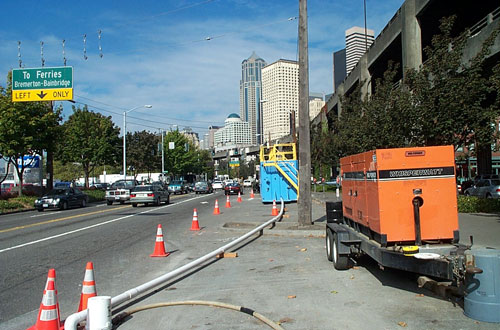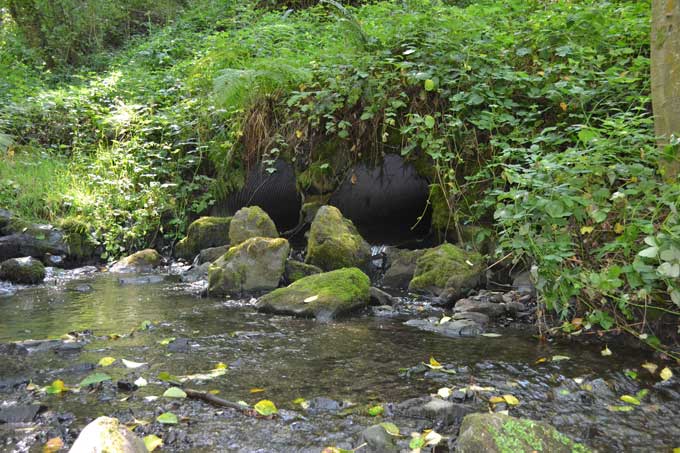Groundwater Resource Assessment
Development and use of groundwater resources requires a thorough understanding of geology, well hydraulics and regulations. Richard has over of 23 years of evaluating groundwater resources under a wide variety of often complex hydrogeologic conditions and regulatory challenges. With an increasingly limited amount of resources, that experience provides a basis for successfully helping clients with projects in a timely and cost-effective fashion.

Aquifer testing for the Alaskan Way Viaduct project
Richard has designed and tested dozens of wells with yields ranging from a couple of gallons per minutes to thousands of gallons per minute. His understanding of aquifer yield and well hydraulics allows for design of highly efficient wells. Richard has designed emergency supply wells for public water supply and hospitals, heating and cooling wells (see below), and dewatering wells (see the Dewatering and Drainage page).
Closed loop heating and cooling systems require pumping groundwater from an aquifer, running the water through a heat exchanger to either heat or cool the water, then injecting the water back into the ground. Richard has designed these types of systems for a proposed educational facility in Eastern Washington, a hospital in Alaska, and an energy company in the Cayman Islands.
With dwindling water supplies and overstressed aquifers, basin analyses are often necessary to evaluate the sustainable yield of an aquifer. An initial water balance is often performed to provide a basis for understanding the hydrology of a basin, and provides the framework for development of a computer model of groundwater flow. Richard developed a computer model of the Highline aquifer system for the City of Seattle to evaluate the feasibility of using Aquifer Storage and Recovery (ARS) to maintain water levels. He also completed an aquifer analysis of the Anchorage Basin to evaluate water supplies for the Anchorage Fish Hatchery.
Groundwater Resource Assessment Project Examples:
Seattle Public Utilities, Greenwood Groundwater
Study, Seattle, WA

Stormwater drainage pipes discharging to Piper's
Creek in Carkeek Park
Richard was Project Hydrogeologist for a study of soil and groundwater conditions in the Greenwood area of Seattle, Washington. A portion of the Greenwood area is underlain by peat and soft soils, and as a result of loading of these soils and declines in the water table, ground settlement has occurred, which has damaged buildings and infrastructure in the area. Richard evaluated the subsurface conditions and determined that both short-term and long-term declines in water levels from drainage of the area, groundwater losses to the storm drain system, reduced infiltration, and construction dewatering have contributed to the settlement. Richard provided recommendations to help limit future settlement including limitations on drawdown as a result of dewatering during future development, and developed a monitoring program to establish baseline conditions by which future declines can be identified. As part of the overall evaluation of the hydrogeologic system, Richard completed a preliminary evaluation of the relationship of groundwater input to Piper’s Creek from the Greenwood area.
Anchorage Fish Hatchery, Anchorage, AK
Richard was Project Hydrogeologist to evaluate the effects of proposed production wells at the Anchorage Fish Hatchery site on local groundwater resources. The project was part of a study being conducted for expansion of the hatchery, and provided a basis for future resource planning and support for securing a water right. Richard constructed a three-dimensional flow model of the Anchorage area to evaluate the impact of the hatchery wells on existing groundwater users in the area. His modeling results indicate that up to 3,000 gpm is available at the hatchery site from the deep aquifer and pumping will have localized drawdown effects on groundwater levels but relatively small basin-wide drawdown effects. Richard’s analysis indicates the proposed pumping rates appear to be sustainable for the long term (up to 50 years) if the assumed current groundwater conditions remain unchanged. Richard also used the model to evaluate the potential for mobilization of contaminants toward the hatchery wells and the potential for salt water intrusion as a result of the additional pumping at the hatchery.
